Text and images Copyright
© 1998 - 2000 John A. Lind
Lines
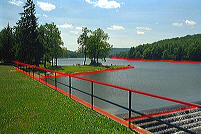 Lines
lead the eye to points or between points within an image. The conscious
use of lines can be used to enhance the prominence of the subject, to tell
the subject's story (what the subject[s] is[are] doing/thinking), or help
create 3-dimensional depth to the image in general. The nature of
the lines can also be used to create a mood.
Lines
lead the eye to points or between points within an image. The conscious
use of lines can be used to enhance the prominence of the subject, to tell
the subject's story (what the subject[s] is[are] doing/thinking), or help
create 3-dimensional depth to the image in general. The nature of
the lines can also be used to create a mood.
Line Psychology
The very nature of the lines in a photograph have a general psychological
effect on how the image is perceived. This effect seems to universally
cut across diverse cultural boundaries and is deeply rooted in our psyche.
Straight Lines
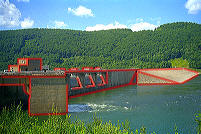 Straight
lines exude hardness, power and strength. In terms of gender they
are thought of as primarily masculine. In the photograph of the dam,
note all the straight lines. Indeed, all the lines defining the dam
are straight. These, combined with the rough textured surface, combine
to give the subject a sense of strength, solidity, hardness and power.
Straight
lines exude hardness, power and strength. In terms of gender they
are thought of as primarily masculine. In the photograph of the dam,
note all the straight lines. Indeed, all the lines defining the dam
are straight. These, combined with the rough textured surface, combine
to give the subject a sense of strength, solidity, hardness and power.
Curved Lines
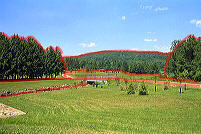 Curved
lines signal softness, tenderness, shyness and calm. In gender they
are a sign of femininity. Note the contrast in mood between this
photograph and the previous, both taken in the same locale on the same
day. This one has near zero straight lines. Two significant
lines, a stream bed and road, are curved. The horizon and tree lines
appear curved also giving the scene a sense of serenity and tranquility.
Curved
lines signal softness, tenderness, shyness and calm. In gender they
are a sign of femininity. Note the contrast in mood between this
photograph and the previous, both taken in the same locale on the same
day. This one has near zero straight lines. Two significant
lines, a stream bed and road, are curved. The horizon and tree lines
appear curved also giving the scene a sense of serenity and tranquility.
Perspective
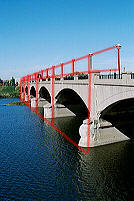 An
object, or portion of an object, will appear smaller as the distance from
the its viewer increases. Photographs capture this same effect called
"perspective." This effect reveals the object or scene's visible
depth. Because a photograph is a flat image, we unconsciously use
intuition and life experience seeing objects of similar shape to perceive
perspective. The bridge photograph demonstrates this. The arches,
railing and light standards all get smaller as the eye travels from the
right side of the image to the left. Our intuition tells us bridges
are level, light standards are the same size, rivers are level (going across
them) and the arches are likely all the same size. The horizontal
lines among them are parallel and equally spaced in reality. However,
from our POV (point of view) they are not. Therefore the part of
the bridge in the image's right side is closer than the part of the bridge
on the left side. We need not see much, if any, of the far shoreline
to come to this conclusion subconsciously and automatically. This
is reinforced by the size of everything that is part of the bridge, including
the footings just above the water, getting smaller at the same rate.
A look at the first and second photographs in this section also show perspective
clearly. The first with the railing and the second with the dam structure
itself.
An
object, or portion of an object, will appear smaller as the distance from
the its viewer increases. Photographs capture this same effect called
"perspective." This effect reveals the object or scene's visible
depth. Because a photograph is a flat image, we unconsciously use
intuition and life experience seeing objects of similar shape to perceive
perspective. The bridge photograph demonstrates this. The arches,
railing and light standards all get smaller as the eye travels from the
right side of the image to the left. Our intuition tells us bridges
are level, light standards are the same size, rivers are level (going across
them) and the arches are likely all the same size. The horizontal
lines among them are parallel and equally spaced in reality. However,
from our POV (point of view) they are not. Therefore the part of
the bridge in the image's right side is closer than the part of the bridge
on the left side. We need not see much, if any, of the far shoreline
to come to this conclusion subconsciously and automatically. This
is reinforced by the size of everything that is part of the bridge, including
the footings just above the water, getting smaller at the same rate.
A look at the first and second photographs in this section also show perspective
clearly. The first with the railing and the second with the dam structure
itself.
Vanishing Points
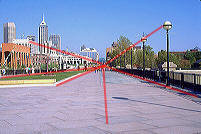 When
a perspective POV shows an object's parallel lines getting closer together,
the vanishing point is where the lines converge and represents theoretically
an infinite distance away from the observer. Obviously something
an infinite distance away cannot be seen in reality, much less captured
in a photograph. In this image, the vanishing point is behind the
rounded top structure far down the street. Note how nearly all the
perspective lines, including the tops of the light standards and a weak
one formed by corners of buildings all lead to the same point. All
images with some form of perspective have one or more vanishing points.
Whether there is only one, or more than one depends on the perspective.
When
a perspective POV shows an object's parallel lines getting closer together,
the vanishing point is where the lines converge and represents theoretically
an infinite distance away from the observer. Obviously something
an infinite distance away cannot be seen in reality, much less captured
in a photograph. In this image, the vanishing point is behind the
rounded top structure far down the street. Note how nearly all the
perspective lines, including the tops of the light standards and a weak
one formed by corners of buildings all lead to the same point. All
images with some form of perspective have one or more vanishing points.
Whether there is only one, or more than one depends on the perspective.
Leading Lines
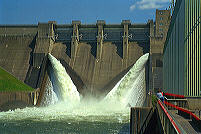 Leading
lines are perspective lines that lead the viewer to the subject or an element
of the subject. There are two elements in the subject of this photograph:
the dam which dominates the image and the person looking at the dam who
is quite small by comparison. There is some color contrast, but it
is the leading lines (also perspective lines) of the railing, benches,
and bottom edge of the corrugated wall that lead the eye to the person.
Without them, the person looking at the dam would not be as prominent in
this image because of small size and lack of strong color contrast.
The eye is lead by these lines toward a vanishing point behind the dam
through where the person is standing.
Leading
lines are perspective lines that lead the viewer to the subject or an element
of the subject. There are two elements in the subject of this photograph:
the dam which dominates the image and the person looking at the dam who
is quite small by comparison. There is some color contrast, but it
is the leading lines (also perspective lines) of the railing, benches,
and bottom edge of the corrugated wall that lead the eye to the person.
Without them, the person looking at the dam would not be as prominent in
this image because of small size and lack of strong color contrast.
The eye is lead by these lines toward a vanishing point behind the dam
through where the person is standing.
Hidden Lines
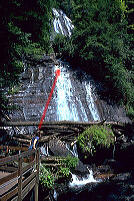 Hidden
lines are those not created by the shapes in the image, but by the position
and orientation of subject elements. In the photograph of the waterfall,
there is one of the most common hidden leading lines from the girl to the
waterfall because that is where she is looking. With a living subject
element, the viewer's eye is naturally drawn to where the subject is looking
if it is elsewhere in the image. This can be used to capture uniqe
effects that help draw attention to the main subject element, or tell the
story about the subject and interaction among subject elements.
Hidden
lines are those not created by the shapes in the image, but by the position
and orientation of subject elements. In the photograph of the waterfall,
there is one of the most common hidden leading lines from the girl to the
waterfall because that is where she is looking. With a living subject
element, the viewer's eye is naturally drawn to where the subject is looking
if it is elsewhere in the image. This can be used to capture uniqe
effects that help draw attention to the main subject element, or tell the
story about the subject and interaction among subject elements. 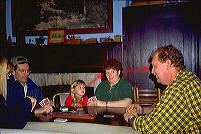 Although the technical aspect of lighting in the photograph of the card
game is not the best, the direction two of the participants are looking
tells a powerful story. There is little doubt whose turn it is next
and that there is some suspense as to what he will do. A direction
of motion can also create a hidden leading line. If it is obvious
a subject element is moving within the image, the eye will also naturally
be drawn to where that element is headed.
Although the technical aspect of lighting in the photograph of the card
game is not the best, the direction two of the participants are looking
tells a powerful story. There is little doubt whose turn it is next
and that there is some suspense as to what he will do. A direction
of motion can also create a hidden leading line. If it is obvious
a subject element is moving within the image, the eye will also naturally
be drawn to where that element is headed. 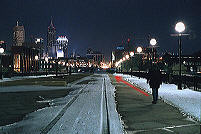 In the night image of the man walking on the bridge (me with the camera
on tripod using the self-timer), it is obvious he is walking toward the
bright lights in the center of the city. Note the direction is also
the same as the perspective lines of the bridge with an apparent destination
at the vanishing point in the bright lights in the distance. In this
image it combines several line and perspective properties working together
to strengthen the perception of the viewer. We know where he is headed
leaving some mystery as to why he is going there and doing so that late
at night with the rest of the locale deserted by traffic and people.
In the night image of the man walking on the bridge (me with the camera
on tripod using the self-timer), it is obvious he is walking toward the
bright lights in the center of the city. Note the direction is also
the same as the perspective lines of the bridge with an apparent destination
at the vanishing point in the bright lights in the distance. In this
image it combines several line and perspective properties working together
to strengthen the perception of the viewer. We know where he is headed
leaving some mystery as to why he is going there and doing so that late
at night with the rest of the locale deserted by traffic and people.
 Lines
lead the eye to points or between points within an image. The conscious
use of lines can be used to enhance the prominence of the subject, to tell
the subject's story (what the subject[s] is[are] doing/thinking), or help
create 3-dimensional depth to the image in general. The nature of
the lines can also be used to create a mood.
Lines
lead the eye to points or between points within an image. The conscious
use of lines can be used to enhance the prominence of the subject, to tell
the subject's story (what the subject[s] is[are] doing/thinking), or help
create 3-dimensional depth to the image in general. The nature of
the lines can also be used to create a mood.
 Straight
lines exude hardness, power and strength. In terms of gender they
are thought of as primarily masculine. In the photograph of the dam,
note all the straight lines. Indeed, all the lines defining the dam
are straight. These, combined with the rough textured surface, combine
to give the subject a sense of strength, solidity, hardness and power.
Straight
lines exude hardness, power and strength. In terms of gender they
are thought of as primarily masculine. In the photograph of the dam,
note all the straight lines. Indeed, all the lines defining the dam
are straight. These, combined with the rough textured surface, combine
to give the subject a sense of strength, solidity, hardness and power.
 Curved
lines signal softness, tenderness, shyness and calm. In gender they
are a sign of femininity. Note the contrast in mood between this
photograph and the previous, both taken in the same locale on the same
day. This one has near zero straight lines. Two significant
lines, a stream bed and road, are curved. The horizon and tree lines
appear curved also giving the scene a sense of serenity and tranquility.
Curved
lines signal softness, tenderness, shyness and calm. In gender they
are a sign of femininity. Note the contrast in mood between this
photograph and the previous, both taken in the same locale on the same
day. This one has near zero straight lines. Two significant
lines, a stream bed and road, are curved. The horizon and tree lines
appear curved also giving the scene a sense of serenity and tranquility.
 An
object, or portion of an object, will appear smaller as the distance from
the its viewer increases. Photographs capture this same effect called
"perspective." This effect reveals the object or scene's visible
depth. Because a photograph is a flat image, we unconsciously use
intuition and life experience seeing objects of similar shape to perceive
perspective. The bridge photograph demonstrates this. The arches,
railing and light standards all get smaller as the eye travels from the
right side of the image to the left. Our intuition tells us bridges
are level, light standards are the same size, rivers are level (going across
them) and the arches are likely all the same size. The horizontal
lines among them are parallel and equally spaced in reality. However,
from our POV (point of view) they are not. Therefore the part of
the bridge in the image's right side is closer than the part of the bridge
on the left side. We need not see much, if any, of the far shoreline
to come to this conclusion subconsciously and automatically. This
is reinforced by the size of everything that is part of the bridge, including
the footings just above the water, getting smaller at the same rate.
A look at the first and second photographs in this section also show perspective
clearly. The first with the railing and the second with the dam structure
itself.
An
object, or portion of an object, will appear smaller as the distance from
the its viewer increases. Photographs capture this same effect called
"perspective." This effect reveals the object or scene's visible
depth. Because a photograph is a flat image, we unconsciously use
intuition and life experience seeing objects of similar shape to perceive
perspective. The bridge photograph demonstrates this. The arches,
railing and light standards all get smaller as the eye travels from the
right side of the image to the left. Our intuition tells us bridges
are level, light standards are the same size, rivers are level (going across
them) and the arches are likely all the same size. The horizontal
lines among them are parallel and equally spaced in reality. However,
from our POV (point of view) they are not. Therefore the part of
the bridge in the image's right side is closer than the part of the bridge
on the left side. We need not see much, if any, of the far shoreline
to come to this conclusion subconsciously and automatically. This
is reinforced by the size of everything that is part of the bridge, including
the footings just above the water, getting smaller at the same rate.
A look at the first and second photographs in this section also show perspective
clearly. The first with the railing and the second with the dam structure
itself.
 When
a perspective POV shows an object's parallel lines getting closer together,
the vanishing point is where the lines converge and represents theoretically
an infinite distance away from the observer. Obviously something
an infinite distance away cannot be seen in reality, much less captured
in a photograph. In this image, the vanishing point is behind the
rounded top structure far down the street. Note how nearly all the
perspective lines, including the tops of the light standards and a weak
one formed by corners of buildings all lead to the same point. All
images with some form of perspective have one or more vanishing points.
Whether there is only one, or more than one depends on the perspective.
When
a perspective POV shows an object's parallel lines getting closer together,
the vanishing point is where the lines converge and represents theoretically
an infinite distance away from the observer. Obviously something
an infinite distance away cannot be seen in reality, much less captured
in a photograph. In this image, the vanishing point is behind the
rounded top structure far down the street. Note how nearly all the
perspective lines, including the tops of the light standards and a weak
one formed by corners of buildings all lead to the same point. All
images with some form of perspective have one or more vanishing points.
Whether there is only one, or more than one depends on the perspective.
 Leading
lines are perspective lines that lead the viewer to the subject or an element
of the subject. There are two elements in the subject of this photograph:
the dam which dominates the image and the person looking at the dam who
is quite small by comparison. There is some color contrast, but it
is the leading lines (also perspective lines) of the railing, benches,
and bottom edge of the corrugated wall that lead the eye to the person.
Without them, the person looking at the dam would not be as prominent in
this image because of small size and lack of strong color contrast.
The eye is lead by these lines toward a vanishing point behind the dam
through where the person is standing.
Leading
lines are perspective lines that lead the viewer to the subject or an element
of the subject. There are two elements in the subject of this photograph:
the dam which dominates the image and the person looking at the dam who
is quite small by comparison. There is some color contrast, but it
is the leading lines (also perspective lines) of the railing, benches,
and bottom edge of the corrugated wall that lead the eye to the person.
Without them, the person looking at the dam would not be as prominent in
this image because of small size and lack of strong color contrast.
The eye is lead by these lines toward a vanishing point behind the dam
through where the person is standing.
 Hidden
lines are those not created by the shapes in the image, but by the position
and orientation of subject elements. In the photograph of the waterfall,
there is one of the most common hidden leading lines from the girl to the
waterfall because that is where she is looking. With a living subject
element, the viewer's eye is naturally drawn to where the subject is looking
if it is elsewhere in the image. This can be used to capture uniqe
effects that help draw attention to the main subject element, or tell the
story about the subject and interaction among subject elements.
Hidden
lines are those not created by the shapes in the image, but by the position
and orientation of subject elements. In the photograph of the waterfall,
there is one of the most common hidden leading lines from the girl to the
waterfall because that is where she is looking. With a living subject
element, the viewer's eye is naturally drawn to where the subject is looking
if it is elsewhere in the image. This can be used to capture uniqe
effects that help draw attention to the main subject element, or tell the
story about the subject and interaction among subject elements.  Although the technical aspect of lighting in the photograph of the card
game is not the best, the direction two of the participants are looking
tells a powerful story. There is little doubt whose turn it is next
and that there is some suspense as to what he will do. A direction
of motion can also create a hidden leading line. If it is obvious
a subject element is moving within the image, the eye will also naturally
be drawn to where that element is headed.
Although the technical aspect of lighting in the photograph of the card
game is not the best, the direction two of the participants are looking
tells a powerful story. There is little doubt whose turn it is next
and that there is some suspense as to what he will do. A direction
of motion can also create a hidden leading line. If it is obvious
a subject element is moving within the image, the eye will also naturally
be drawn to where that element is headed.  In the night image of the man walking on the bridge (me with the camera
on tripod using the self-timer), it is obvious he is walking toward the
bright lights in the center of the city. Note the direction is also
the same as the perspective lines of the bridge with an apparent destination
at the vanishing point in the bright lights in the distance. In this
image it combines several line and perspective properties working together
to strengthen the perception of the viewer. We know where he is headed
leaving some mystery as to why he is going there and doing so that late
at night with the rest of the locale deserted by traffic and people.
In the night image of the man walking on the bridge (me with the camera
on tripod using the self-timer), it is obvious he is walking toward the
bright lights in the center of the city. Note the direction is also
the same as the perspective lines of the bridge with an apparent destination
at the vanishing point in the bright lights in the distance. In this
image it combines several line and perspective properties working together
to strengthen the perception of the viewer. We know where he is headed
leaving some mystery as to why he is going there and doing so that late
at night with the rest of the locale deserted by traffic and people.